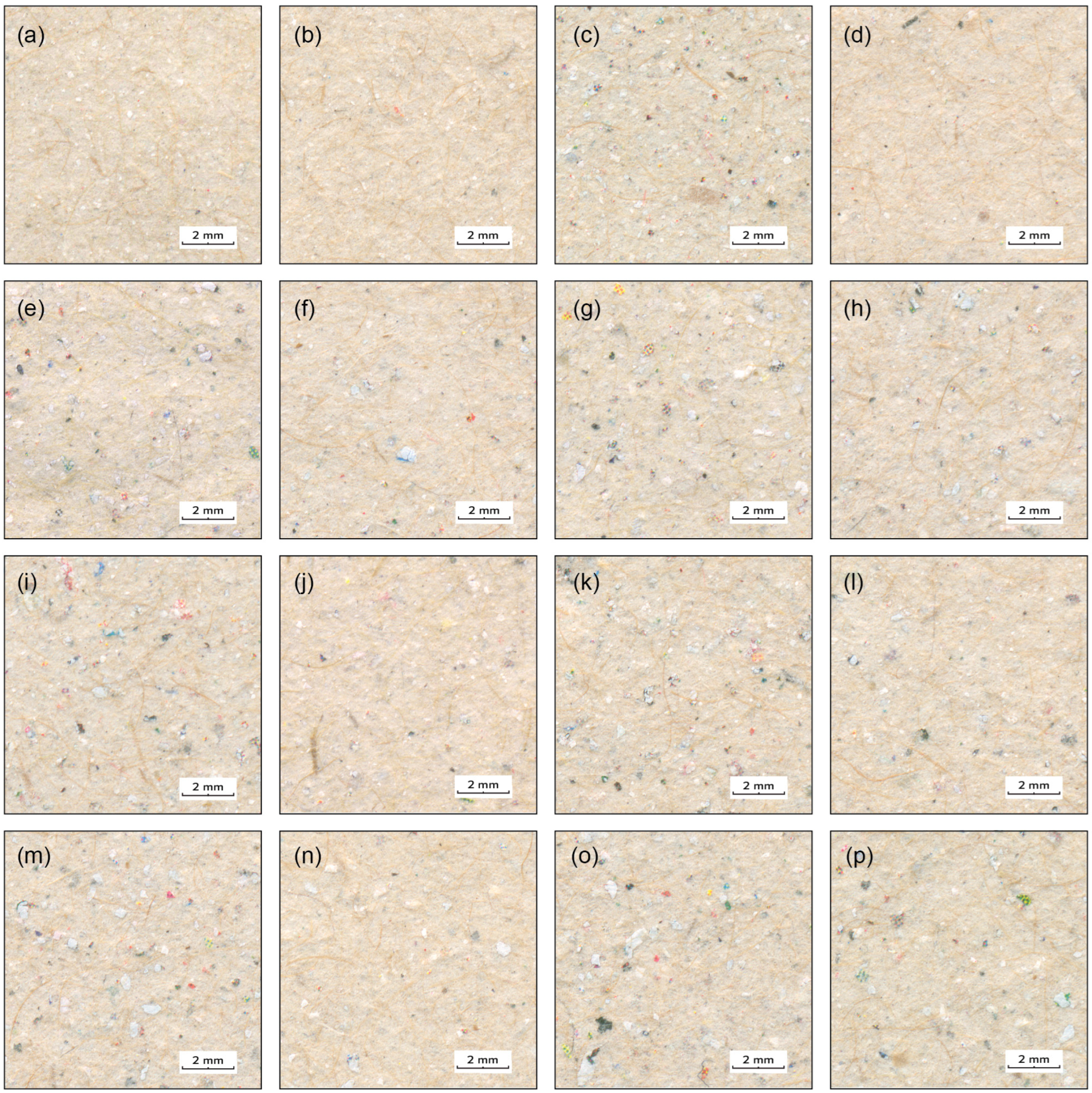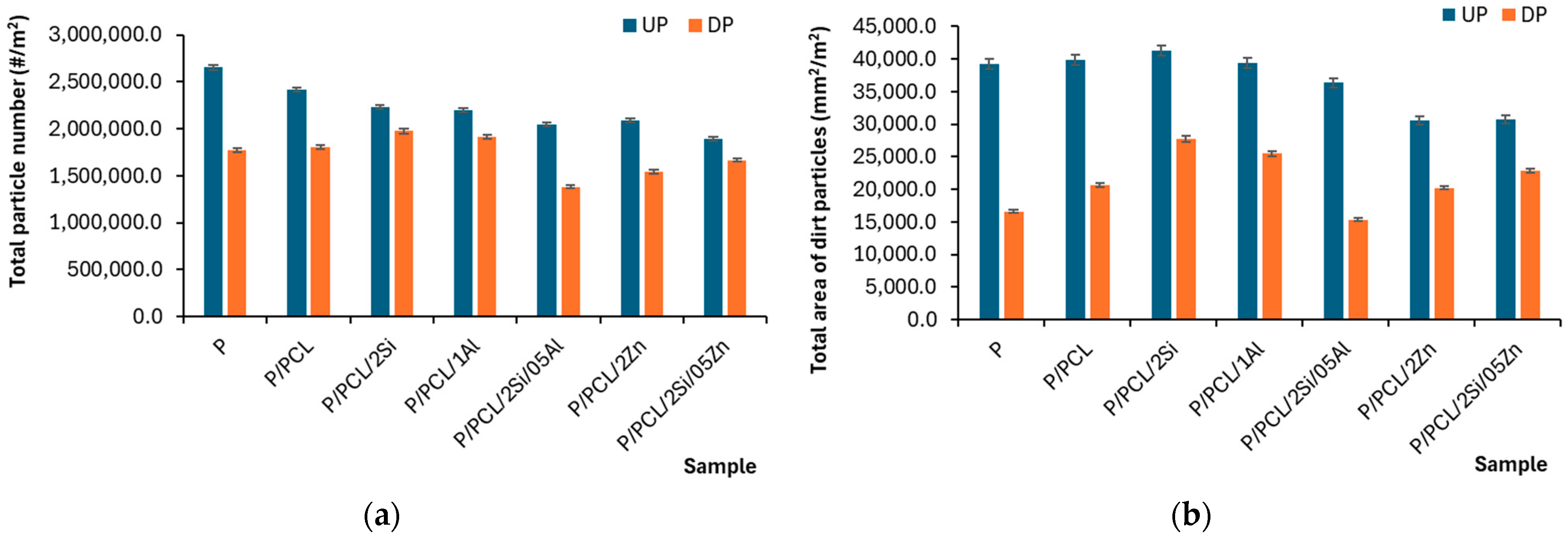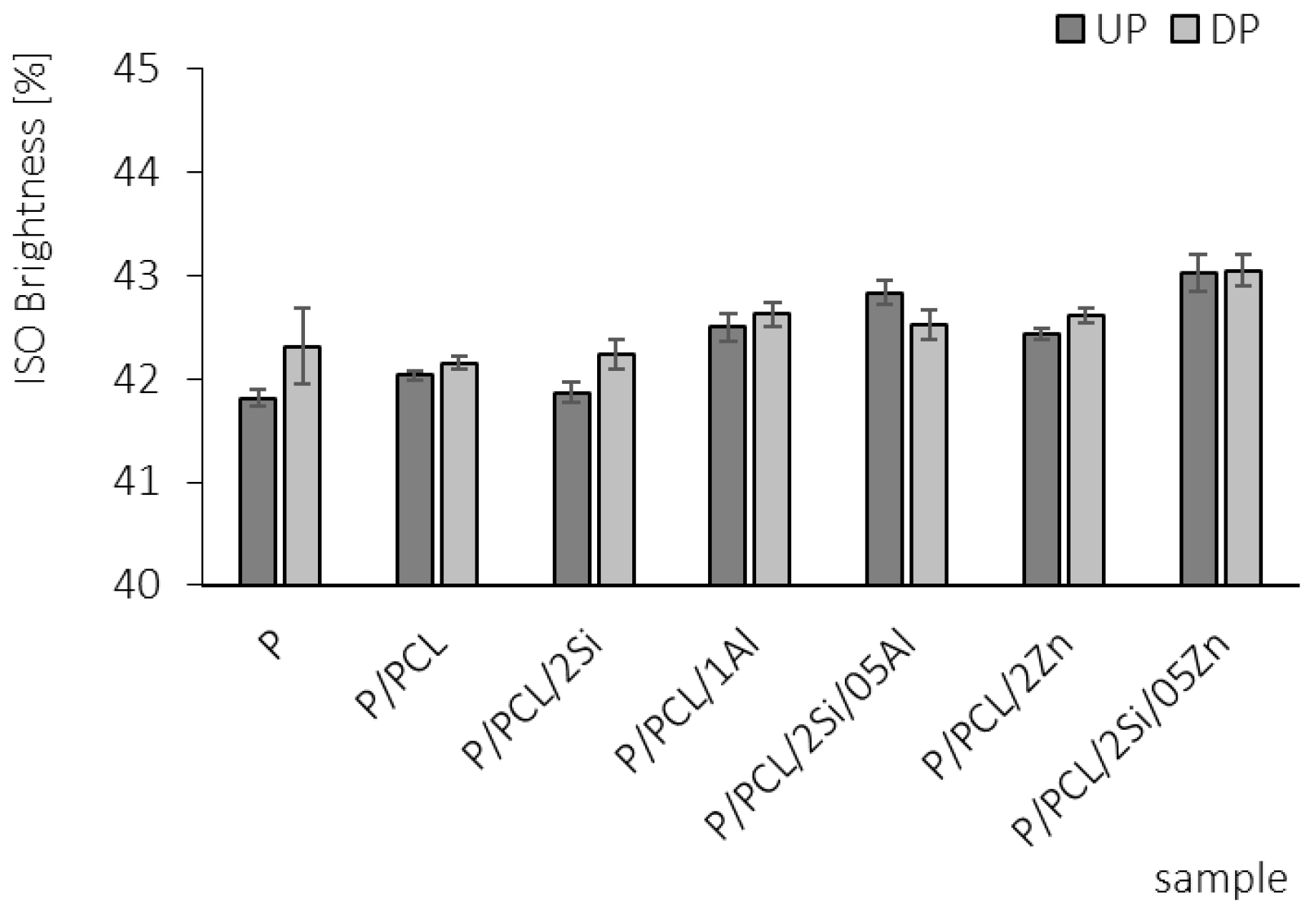Effect of PCL Nanocomposite Coatings on the Recyclability of Paperboard Packaging
Abstract
1. Introduction
2. Results
3. Discussion
4. Materials and Methods
4.1. Materials
4.2. Coating Application
4.3. Recycling Process
4.4. Deinking Efficiency
4.5. Mechanical Properties
5. Conclusions
Author Contributions
Funding
Institutional Review Board Statement
Informed Consent Statement
Data Availability Statement
Conflicts of Interest
References
- Pivnenko, K.; Olsson, M.E.; Götze, R.; Eriksson, E.; Astrup, T.F. Quantification of chemical contaminants in the paper and board fractions of municipal solid waste. Waste Manag. 2016, 51, 43–54. [Google Scholar] [CrossRef] [PubMed]
- CEPI. KEY STATISTICS 2023; CEPI: Brussels, Belgium, 2023. [Google Scholar]
- CEPI. Paper-Based Packaging Recyclability Guidelines; CEPI: Brussels, Belgium, 2019. [Google Scholar]
- Holik, H. (Ed.) Handbook of Paper and Board; Wiley-VCH: Weinheim, Germany, 2013. [Google Scholar]
- Smithers. How Will the Print Industry Change in 2021—And Beyond? Available online: https://whattheythink.com/articles/104174-how-will-print-industry-change-2021-beyond/ (accessed on 14 May 2021).
- Statista. Global Consumption of Paper and Cardboard 1961–2023. Available online: https://www.statista.com/statistics/270319/consumption-of-paper-and-cardboard-since-2006/ (accessed on 20 February 2025).
- Runte, S.; Putz, H.-J.; Bussini, D.; Limongi, L.; Elegir, G. Recyclability criteria for paper based packaging products. Cellul. Chem. Technol. 2015, 49, 667–676. [Google Scholar]
- Faul, A. Quality requirements in graphic paper recycling. Cellul. Chem. Technol. 2010, 44, 451–460. [Google Scholar]
- Vukoje, M.; Rožić, M. Various valorisation routes of paper intended for recycling—A Review. Cellul. Chem. Technol. 2018, 52, 515–541. [Google Scholar]
- Grossmann, H.; Handke, T.; Brenner, T. Handbook of Recycling—State-of-the-Art for Practitioners, Analysts, and Scientists; Worrell, E., Reuter, M.A., Eds.; Elsevier: Amsterdam, The Netherlands, 2014. [Google Scholar]
- Jiang, C.; Ma, J. De-Inking of Waste Paper: Flotation. Enzym. Deinking Technol. 2000, 1, 2537–2544. [Google Scholar]
- Carré, B.; Magnin, L. Digital prints: A survey of the various deinkability behaviours In Proceedings of the 7th Research Forum on Recycling, PAPTAC, Quebec, QC, Canada, 27–29 September 2004.
- Blanco, A.; Miranda, R.; Monte, M.C. Extending the limits of paper recycling: Improvements along the paper value chain. For. Syst. 2013, 22, 471–483. [Google Scholar] [CrossRef]
- Jamnicki Hanzer, S.; Rožić, M.; Vukoje, M.; Jukić, M.; Galić, A. Safety Evaluation of Deinked Pulp Containing Offset Thermochromic Inks. BioResources 2018, 13, 678–690. [Google Scholar] [CrossRef]
- Khan, M.R.; Sadiq, M.B.; Vápenka, L.; Volpe, S.; Rajchl, A.; Torrieri, E. Role of quality assessment of the recycled packaging material in determining its safety profile as food contact material. Waste Manag. 2024, 188, 72–85. [Google Scholar] [CrossRef]
- Vukoje, M.; Mirković, I.B.; Bolanča, Z. Influence of printing technique and printing conditions on prints recycling efficiency and effluents quality. Sustainability 2022, 14, 335. [Google Scholar] [CrossRef]
- Upola, H.; Laitinen, O.; Körkkö, M.; Ämmälä, A. Applying image analysis to measure flake content and flake size distribution in pulping of packaging board. Nord. Pulp Pap. Res. J. 2015, 30, 536–540. [Google Scholar] [CrossRef]
- Miranda, R.; Monte, M.C.; Blanco, A. Analysis of the quality of the recovered paper from commingled collection systems. Resour. Conserv. Recycl. 2013, 72, 60–66. [Google Scholar] [CrossRef]
- Miranda, R.; Concepcion Monte, M.; Blanco, A. Impact of increased collection rates and the use of commingled collection systems on the quality of recovered paper. Part 1: Increased collection rates. Waste Manag. 2011, 31, 2208–2216. [Google Scholar] [CrossRef]
- Miranda, R.; Blanco, A. Environmental awareness and paper recycling. Cellul. Chem. Technol. 2010, 44, 431–449. [Google Scholar]
- Iosip, A.; Nicu, R.; Ciolacu, F.; Bobu, E. Influence of recoverd paper quality on recycled pulp properties. Cellul. Chem. Technol. 2010, 44, 513–519. [Google Scholar]
- Aydemir, C.; Yenidoğan, S.; Tutak, D. Sustainability in the Print and Packaging Industry. Cellul. Chem. Technol. 2023, 57, 565–577. [Google Scholar] [CrossRef]
- Pivnenko, K.; Eriksson, E.; Astrup, T.F. Waste paper for recycling: Overview and identification of potentially critical substances. Waste Manag. 2015, 45, 134–142. [Google Scholar] [CrossRef]
- Vukoje, M.; Bolanča Mirković, I.; Bešlić, M.; Petković, G. The influence of artificial aging on recyclability and mechanical stability of pharmaceutical packaging. In Proceedings of the 10th International Symposium GRID, Novi Sad, Serbia, 12–14 November 2020; Dedijer, S., Ed.; University of Novi Sad, Faculty of Technical Sciences, Department of Graphic Engineering and Design: Novi Sad, Serbia, 2020; pp. 251–259. [Google Scholar]
- Iosip, A.; Dobon, A.; Hortal, M.; Bobu, E. The influence of contaminants in the environmental impact of recovered paper: A life cycle assessment perspective. Int. J. Life Cycle Assess. 2012, 17, 1050–1058. [Google Scholar] [CrossRef]
- Aguilar-Rivera, N. Emerging technology for sustainable production of bleached pulp from recovered cardboard. Clean Technol. Environ. Policy 2021, 23, 2575–2588. [Google Scholar] [CrossRef]
- Tikhomirova, E.; Aleksandrov, D.; Tofanica, B.M.; Mikhailidi, A. Evaluation of Recycled Paperboard Properties and Characteristics. Appl. Sci. 2024, 14, 1661. [Google Scholar] [CrossRef]
- Adibi, A.; Trinh, B.M.; Mekonnen, T.H. Recent progress in sustainable barrier paper coating for food packaging applications. Prog. Org. Coat. 2023, 181, 107566. [Google Scholar] [CrossRef]
- Bhardwaj, S.; Kaur, P.; Bhardwaj, N.K.; Negi, Y.S. Surface application of different concentrations of chitosan on recycled paper and its impact on packaging properties. J. Coat. Technol. Res. 2023, 20, 1285–1298. [Google Scholar] [CrossRef]
- Kunam, P.K.; Ramakanth, D.; Akhila, K.; Gaikwad, K.K. Bio-based materials for barrier coatings on paper packaging. Biomass Convers. Biorefin. 2024, 14, 12637–12652. [Google Scholar] [CrossRef]
- Zhang, H.; Bussini, D.; Hortal, M.; Elegir, G.; Mendes, J.; Jordá Beneyto, M. PLA coated paper containing active inorganic nanoparticles: Material characterization and fate of nanoparticles in the paper recycling process. Waste Manag. 2016, 52, 339–345. [Google Scholar] [CrossRef]
- CIE Central Bureau. Colorimetry, 3rd ed.; CIE Central Bureau: Vienna, Austria, 2004. [Google Scholar]
- Singh, A.; Kaur, A.; Yadav, R.D.; Mahajan, R. An efficient eco-friendly approach for recycling of newspaper waste. 3Biotech 2019, 9, 51. [Google Scholar] [CrossRef] [PubMed]
- Jamnicki, S.; Àngels, M.; Serra, P.; Lozo, B.; Stanic, M.; Barusic, L. Deinking Flotation of Recycled Linerboard for Food Packaging Applications. Cellul. Chem. Technol. 2010, 44, 481–488. [Google Scholar]
- Khantayanuwong, S.; Boonpitaksakul, W.; Chitbanyong, K.; Pisutpiched, S.; Puangsin, B. Physical properties of handsheets derived from Coi (Streblus asper Lour.) pulp fiber as papermaking material traced from ancient times. BioResources 2021, 16, 6201–6211. [Google Scholar] [CrossRef]
- Zhang, M.; Zhang, D.; Feng, Y.; Min, D.; Dai, H. The Optimization of the Water Footprint and Strength Properties of Handsheets by the Extreme Vertices Mixture Design. BioResources 2015, 10, 5830–5844. [Google Scholar] [CrossRef]
- Tayeb, S.A.H.M.; Jahan Latibari, A.; Tajdini, A.; Sepidehdam, S.M.J. The influence of pulp refining on de-inking potential and strength properties of ink jet printed paper. BioResources 2012, 7, 3837–3846. [Google Scholar] [CrossRef]
- Bota, J.; Kratofil Krehula, L.; Katančić, Z.; Brozović, M.; Hrnjak-Murgić, Z. Surface characteristics and enhancement of water vapour properties of paperboard coated with polycaprolactone nanocomposites. J. Adhes. Sci. Technol. 2017, 31, 466–486. [Google Scholar] [CrossRef]
- Bota, J.; Vukoje, M.; Brozović, M.; Hrnjak-Murgić, Z. Reduced Water Permeability of Biodegradable PCL Nanocomposite Coated Paperboard Packaging. Chem. Biochem. Eng. Q. 2017, 31, 417–424. [Google Scholar] [CrossRef]
- Yang, S.; Shen, J.; He, T.; Chen, C.; Wang, J.; Tang, Y. Flotation de-inking for recycling paper: Contrasting the effects of three mineral oil-free offset printing inks on its efficiency. Environ. Sci. Pollut. Res. 2022, 29, 89283–89294. [Google Scholar] [CrossRef]
- Fairbank, M.; Keenan, D.; Peters, H.; Prein, M.; Schwarzbach, A.; Wells, L. Effect of recovered paper quality and deinking process parameters on dirt levels in newsprint. Pulp Pap. Can. 2006, 107, 64–67. [Google Scholar]
- Kumar, A.; Dutt, D. A comparative study of conventional chemical deinking and environment-friendly bio-deinking of mixed office wastepaper. Sci. Afr. 2021, 12, e00793. [Google Scholar] [CrossRef]
- Vukoje, M.; Kulčar, R.; Itrić, K.; Rožić, M. Spectroscopic evaluation of thermochromic printed cardboard biodegradation. In Proceedings of the Ninth International Symposium GRID, Novi Sad, Serbia, 8–10 November 2018; pp. 87–96. [Google Scholar]
- Vukoje, M.; Itrić Ivanda, K.; Kulčar, R.; Marošević Dolovski, A. Spectroscopic Stability Studies of Pressure Sensitive Labels Facestock Made from Recycled Post-Consumer Waste and Agro-Industrial By-Products. Forests 2021, 12, 1703. [Google Scholar] [CrossRef]
- Obradovic, D.; Mishra, L.N. Mechanical Properties Of Recycled Paper And Cardboard. J. Eng. Exact. Sci. 2020, 6, 0429–0434. [Google Scholar] [CrossRef]
- Zhang, X.; Bo, X.; Cong, L.; Wei, L.; McDonald, A.G. Characteristics of undeinked, alkaline deinked, and neutral deinked old newspaper fibers reinforced recycled polypropylene composites. Polym. Compos. 2018, 39, 3537–3544. [Google Scholar] [CrossRef]
- ISO 187:1990; Paper, Board and Pulps—Standard Atmosphere for Conditioning and Testing and Procedure for Monitoring the Atmosphere and Conditioning of Samples. ISO: Geneva, Switzerland, 1990.
- ISO 21993:2020; Paper and Pulp—Deinkability Test for Printed Paper Products. ISO: Geneva, Switzerland, 2020.
- ISO 5269-2:2004; Pulps—Preparation of Laboratory Sheets for Physical Testing—Part 2: Rapid-Köthen Method. ISO: Geneva, Switzerland, 2004.
- ISO 2470-1:2016; Paper, Board and Pulps—Measurement of Diffuse Blue Reflectance Factor—Part 1: Indoor Daylight Conditions (ISO Brightness). ISO: Geneva, Switzerland, 2016.
- ISO 11475:2017; Paper and Board—Determination of CIE Whiteness, D65/10 Degrees (Outdoor Daylight). ISO: Geneva, Switzerland, 2017.
- ISO 2759:2001; Board—Determination of bursting strength. ISO: Geneva, Switzerland, 2001.






| Sample | UP | DP | ||
|---|---|---|---|---|
| a* | b* | a* | b* | |
| blank | 2.40 | 9.41 | 2.60 | 7.90 |
| P | 2.31 | 6.93 | 2.63 | 7.53 |
| P/PCL | 2.36 | 7.23 | 2.53 | 7.56 |
| P/PCL/2Si | 2.24 | 7.78 | 2.10 | 6.59 |
| P/PCL/1Al | 2.41 | 7.12 | 2.68 | 7.48 |
| P/PCL/2Si/05Al | 1.85 | 7.66 | 2.32 | 8.38 |
| P/PCL/2Zn | 1.96 | 7.67 | 2.18 | 8.07 |
| P/PCL/2Si/05Zn | 2.30 | 7.45 | 2.47 | 7.70 |
| Sample | Burst Strength (kPa) | StDev | Successful Tests | Sample Thickness (µm) | |
|---|---|---|---|---|---|
| blank | 190 | 10.9 | 5/5 | 293 | UP |
| P | >160 | - | 0/5 | 289 | |
| P/PCL | >160 | - | 0/5 | 294 | |
| P/PCL/2Si | >160 | - | 0/5 | 298 | |
| P/PCL/1Al | >160 | - | 0/5 | 291 | |
| P/PCL/2Si/05Al | >160 | - | 0/5 | 288 | |
| P/PCL/2Zn | >160 | - | 0/5 | 293 | |
| P/PCL/2Si/05Zn | >160 | - | 0/5 | 296 | |
| blank | 205 | 10.4 | 5/5 | 294 | DP |
| P | 204 | 8.3 | 5/5 | 272 | |
| P/PCL | 191 | 10.1 | 5/5 | 292 | |
| P/PCL/2Si | 178 | 7.4 | 5/5 | 294 | |
| P/PCL/1Al | 181 | 12 | 5/5 | 293 | |
| P/PCL/2Si/05Al | 174 | - | 3/5 | 293 | |
| P/PCL/2Zn | 173 | - | 2/5 | 300 | |
| P/PCL/2Si/05Zn | 163 | - | 2/5 | 297 |
| Sample Abbreviation | Ethyl Acetate | PCL | SiO2 | Al2O3 | Zn |
|---|---|---|---|---|---|
| P | - | - | - | - | - |
| P/PCL | 90 | 10 | - | - | - |
| P/PCL/2Si | 88 | 10 | 2 | - | - |
| P/PCL/1Al | 89 | 10 | 1 | - | - |
| P/PCL/2Zn | 88 | 10 | 2 | - | - |
| P/PCL/2Si/05Al | 87.5 | 10 | 2 | 0.5 | - |
| P/PCL/2Si/05Zn | 87.5 | 10 | 2 | - | 0.5 |
Disclaimer/Publisher’s Note: The statements, opinions and data contained in all publications are solely those of the individual author(s) and contributor(s) and not of MDPI and/or the editor(s). MDPI and/or the editor(s) disclaim responsibility for any injury to people or property resulting from any ideas, methods, instructions or products referred to in the content. |
© 2025 by the authors. Licensee MDPI, Basel, Switzerland. This article is an open access article distributed under the terms and conditions of the Creative Commons Attribution (CC BY) license (https://creativecommons.org/licenses/by/4.0/).
Share and Cite
Vukoje, M.; Bota, J. Effect of PCL Nanocomposite Coatings on the Recyclability of Paperboard Packaging. Recycling 2025, 10, 53. https://doi.org/10.3390/recycling10020053
Vukoje M, Bota J. Effect of PCL Nanocomposite Coatings on the Recyclability of Paperboard Packaging. Recycling. 2025; 10(2):53. https://doi.org/10.3390/recycling10020053
Chicago/Turabian StyleVukoje, Marina, and Josip Bota. 2025. "Effect of PCL Nanocomposite Coatings on the Recyclability of Paperboard Packaging" Recycling 10, no. 2: 53. https://doi.org/10.3390/recycling10020053
APA StyleVukoje, M., & Bota, J. (2025). Effect of PCL Nanocomposite Coatings on the Recyclability of Paperboard Packaging. Recycling, 10(2), 53. https://doi.org/10.3390/recycling10020053






